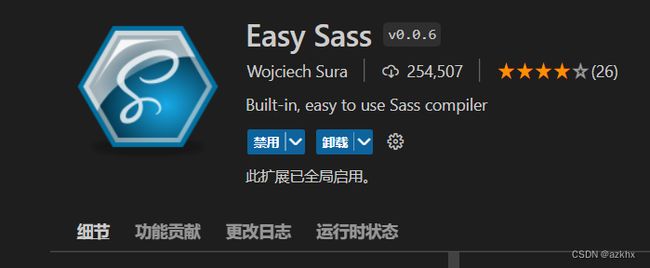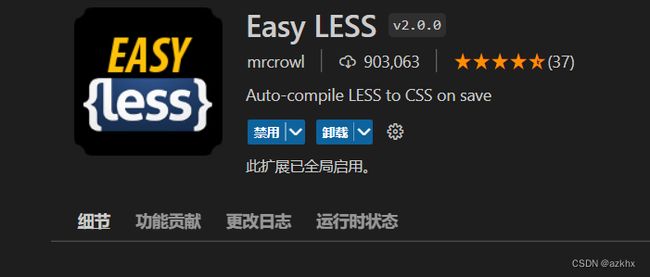使用sass和less便捷的书写CSS
SASS
-
SASS官网
-
世界上最成熟、最稳定、最强大的专业级CSS扩展语言!
-
sass是一个 css 的预编译工具 -
也就是能够 更优雅 的书写 css
-
sass写出来的东西 浏览器不认识 -
依旧是要转换成 css 在浏览器中运行
-
这个时候就需要一个工具来帮我们做
安装 sass 环境
-
以前的
sass需要依赖一个ruby的环境 -
现在的
sass需要依赖一个python的环境 -
但是我们的 node 强大了以后,我们只需要依赖
node环境也可以 -
需要我们使用 npm 安装一个全局的
sass环境就可以了# 安装全局 sass 环境 $ npm install sass -g
编译 sass
-
有了全局的
sass环境以后 -
我们就可以对
sass的文件进行编译了 -
sass的文件后缀有两种,一种是.sass一种是.scss -
他们两个的区别就是有没有
{}和; -
.scss文件h1 { width: 100px; height: 200px; } -
.sass文件h1 width: 100px height: 200px -
我们比较常用的还是
.scss文件 -
因为
.sass我们写不习惯,当然,如果你能写习惯也比较好用 -
我们先不管里面的的什么内容,至少这个
.scss或者.sass文件浏览器就不认识 -
我们就要用指令把 这两种 文件变成 css 文件
# 把 index.scss 编译,输出成 index.css $ sass index.scss index.css -
这样我们就能得到一个 css 文件,在页面里面也是引入一个 css 文件就可以了
实时编译
-
我们刚才的编译方式只能编译一次
-
当你修改了文件以后要从新执行一遍指令才可以
-
实时编译就是随着你文件的修改,自动从新编译成 css 文件
-
也是使用指令来完成
# 实时监控 index.scss 文件,只要发生修改就自动编译,并放在 index.css 文件里面 $ sass --watch index.scss:index.css -
然后你只要修改
index.scss文件的内容,index.css文件中的内容会自动更新
实时监控目录
-
之前的实时监控只能监控一个文件
-
但是我们有可能要写很多的文件
-
所以我们要准备一个文件夹,里面放的全部都是 sass 文件
-
实时的把里面的每一个文件都编译到 css 文件夹里面
-
依旧是使用指令的形式来完成
# 实时监控 sass 这个目录,只要有变化,就会实时响应在 css 文件夹下 $ sass --watch sass:css -
这样,只要你修改 sass 文件夹下的内容,就会实时的相应在 css 文件夹中
-
你新添加一个文件也会实时响应
-
但是你删除一个文件,css 文件夹中不会自动删除,需要我们自己手动删除
便捷的使用
VScode里面有个插件easy-sass安装之后可以省略上述步骤

sass 语法
- 我们能编译
sass文件了,接下来我们就该学习一下sass的语法了 - 为什么他这么强大,这么好用,都是靠强大的语法
.sass和.scss文件的语法是一样的,只不过区别就是{}和;
变量
-
定义一个变量,在后面的代码中使用
-
使用
$来定义变量// 定义一个 $c 作为变量,值是 红色 $c: red; h1 { // 在使用 $c 这个变量 color: $c; } -
上面定义的变量全局都可以使用
-
我们也可以在规则块内定义私有变量
h1 { // 这个 $w 变量只能在 h1 这个规则块中使用 $w: 100px; width: $w; }
嵌套
-
sass里面我们最长用到的就是嵌套了 -
而且相当的好用
h1 { width: 100px; div { width: 200px; } } // 编译结果 h1 { width: 100px; } h1 div { width: 200px; } -
这个就是嵌套,理论上可以无限嵌套下去
ul { width: 100px; li { width: 90px; div { width: 80px; p { width: 70px; span: { color: red; } } } } }
嵌套中的 &
-
在嵌套中还有一个标识符是
&我们可以使用 -
先来看一个例子
div { width: 100px; height: 100px; hover { width: 200px; } } // 我想的是 div 被鼠标悬停的时候 width 变成 200 // 但是编译结果却是 div { width: 100px; height: 100px; } div :hover { width: 200px; } -
和预想的结果不一样了
-
这个时候就要用到
&来连接了div { width: 100px; height: 100px; &:hover { width: 200px; } } // 编译结果 div { width: 100px; height: 100px; } div:hover { width: 200px; } -
这个时候就和我需要的一样了
群组嵌套
-
群组嵌套就是多个标签同时嵌套
div { width: 100px; .box1, .box2, .box3 { color: red; } } // 编译结果 div { width: 100px; } div .box1, div .box2, div .box3 { color: red; } -
还有一种就是多个标签同时嵌套一个标签
h1, h2, h3 { width: 100px; .box { color: red; } } // 编译结果 h1, h2, h3 { width: 100px; } h1 .box, h2 .box, h3 .box { color: red; }
嵌套属性
-
在
scss里面还有一种特殊的嵌套 -
叫做 属性嵌套
-
和选择器嵌套不一样,是写属性的时候使用的
div { border: { style: solid; width: 10px; color: pink; } } // 编译结果 div { border-style: solid; border-width: 10px; border-color: pink; } -
这个属性嵌套还可以有一些特殊使用
div { border: 1px solid #333 { bottom: none; } } // 编译结果 div { border: 1px solid #333; border-bottom: none; }
判断
-
和其他语言一样的,也有判断语句
$className: desc; div{ font-size:20px; @if $className == 'price'{ color: red; } @else{ color: #ccc; } }
循环
-
和其他语言一样的,也有循环语句
/*上述代码中,循环一共循环了三次,从 $i 的值为 1 开始循环,一直到 3 结束,并且包括了 3*/ @for $i from 1 through 3{ ul li:nth-child(#{$i}){ width: $i * 100px; background-color: yellow; } } /*编译后效果*/ ul li:nth-child(1) { width: 100px; background-color: yellow; } ul li:nth-child(2) { width: 200px; background-color: yellow; } ul li:nth-child(3) { width: 300px; background-color: yellow; }
混入
-
也叫 混合器
-
其实就是定义一个 “函数” 在
scss文件中使用// 定义一个混合器使用 @mixin 关键字 @mixin radius { -webkit-border-radius: 10px; -moz-border-radius: 10px; -ms-border-radius: 10px; -o-border-radius: 10px; border-radius: 10px; } -
上面是定义好的一个混合器
-
他是不会被编译的,只有当你使用了他以后,才会被编译
// 使用混合器使用 @include 关键字 div { width: 100px; height: 100px; @include radius; } -
这个就是吧刚才定义的混合器拿过来使用
-
编译结果
div { width: 100px; height: 100px; -webkit-border-radius: 10px; -moz-border-radius: 10px; -ms-border-radius: 10px; -o-border-radius: 10px; border-radius: 10px; }
混合器传参
-
我们既然说了,混合器就像一个 “函数” 一样,那么就一定可以像 “函数” 一样传递参数
-
和 “函数” 的使用方式一样,在定时的时候是 “形参”,在调用的时候是 “实参”
// 定义混合器 @mixin my_transition($pro, $dur, $delay, $tim) { -webkit-transition: $pro $dur $delay $tim; -moz-transition: $pro $dur $delay $tim; -ms-transition: $pro $dur $delay $tim; -o-transition: $pro $dur $delay $tim; transition: $pro $dur $delay $tim; } -
使用这个混合器的时候传递 “实参”
div { width: 100px; height: 100px; @include my_transition(all, 1s, 0s, linear); } -
编译结果
div { width: 100px; height: 100px; -webkit-transition: all 1s 0s linear; -moz-transition: all 1s 0s linear; -ms-transition: all 1s 0s linear; -o-transition: all 1s 0s linear; transition: all 1s 0s linear; } -
写了多少个 “形参”,那么调用的时候就要传递多少个 “实参”
-
不然会报错的
参数默认值
-
我们在定义混合器的时候,也可以给一些参数写一些默认值
-
这样一来,就可以不传递 “实参” 了
// 设置一些带有默认值的参数 @mixin my_transition($dur: 1s, $pro: all, $delay: 0s, $tim: linear) { -webkit-transition: $dur $pro $delay $tim; -moz-transition: $dur $pro $delay $tim; -ms-transition: $dur $pro $delay $tim; -o-transition: $dur $pro $delay $tim; transition: $dur $pro $delay $tim; } -
使用的时候,如果你不传递,那么就是使用默认值
div { width: 100px; height: 100px; // 使用的时候,只传递一个,剩下的使用默认值 @include my_transition(2s); } -
编译结果
div { width: 100px; height: 100px; -webkit-transition: 2s all 0s linear; -moz-transition: 2s all 0s linear; -ms-transition: 2s all 0s linear; -o-transition: 2s all 0s linear; transition: 2s all 0s linear; }
继承
-
在
sass里面使用继承可以大大的提高开发效率 -
其实继承很简单,就是把之前写过的选择器里面的内容直接拿过来一份
div { width: 100px; height: 100px; background-color: pink; } -
这个是之前写过的一个规则样式表
-
接下来我要写另外一个样式了,发现我要写的一些内容和之前这个 div 一样,并且还有一些我自己的内容
-
那么我就可以把这个样式表先继承下来,再写我自己的内容就好了
p { @extend div; font-size: 20px; color: red; } -
编译结果
div, p { width: 100px; height: 100px; background-color: pink; } p { font-size: 20px; color: red; }
注释
-
在
scss文件中的注释分为几种-
编译的时候不会被编译的注释
// 我是一个普通注释,在编译的时候,我就被过滤了 -
编译的时候会被编译的注释
/* 我在编译的时候,会被一起编译过去 */ -
强力注释
/*! 我是一个强力注释,不光编译的时候会被编译过去,将来压缩文件的时候也会存在 */
-
导入文件
-
我们刚才学过了定义变量,定义混合器
-
而这两个内容在定义过以后,如果没有使用,是不会被编译出内容的
-
所以我们可以把变量单独写一个文件,混合器单独写一个文件,然后直接导入后使用
// 我是 variable.scss $w: 100px; $h: 200px; $c: pink; // 我是 mixin.scss @mixin my_transition($dur: 1s, $pro: all, $delay: 0s, $tim: linear) { -webkit-transition: $dur $pro $delay $tim; -moz-transition: $dur $pro $delay $tim; -ms-transition: $dur $pro $delay $tim; -o-transition: $dur $pro $delay $tim; transition: $dur $pro $delay $tim; } @mixin radius { -webkit-border-radius: 10px; -moz-border-radius: 10px; -ms-border-radius: 10px; -o-border-radius: 10px; border-radius: 10px; } -
然后在我们的主要文件中把这个两个文件导入进来就行了
// 我是 index.scss @import './variable.scss'; @import './mixin.scss'; div { width: $w; height: $h; background-color: $c; @include radius; } h1 { @include my_transition; } -
编译结果
div { width: 100px; height: 200px; background-color: pink; -webkit-border-radius: 10px; -moz-border-radius: 10px; -ms-border-radius: 10px; -o-border-radius: 10px; border-radius: 10px; } h1 { -webkit-transition: 1s all 0s linear; -moz-transition: 1s all 0s linear; -ms-transition: 1s all 0s linear; -o-transition: 1s all 0s linear; transition: 1s all 0s linear; }
less
便捷的使用
VScode里面有个插件easy-less安装之后可以省略上述步骤

less和sass的不同
less和sass在变量定义上不同,sass是用$定义,而less是用@定义。
定义函数的时候比sass简单,直接选择器(){}就可以实现函数的定义
判断语句
@a: desc;
.size() when (@a = desc){
font-size: 66px;
}
.size(){
font-size: 20px;
}
p{
.size()
}
循环语句
.loop(@i) when (@i <= 5){
p:nth-child(@{i}){
width: 100 * @i
}
.loop(@i+1)
}
div{
.loop(1)
}